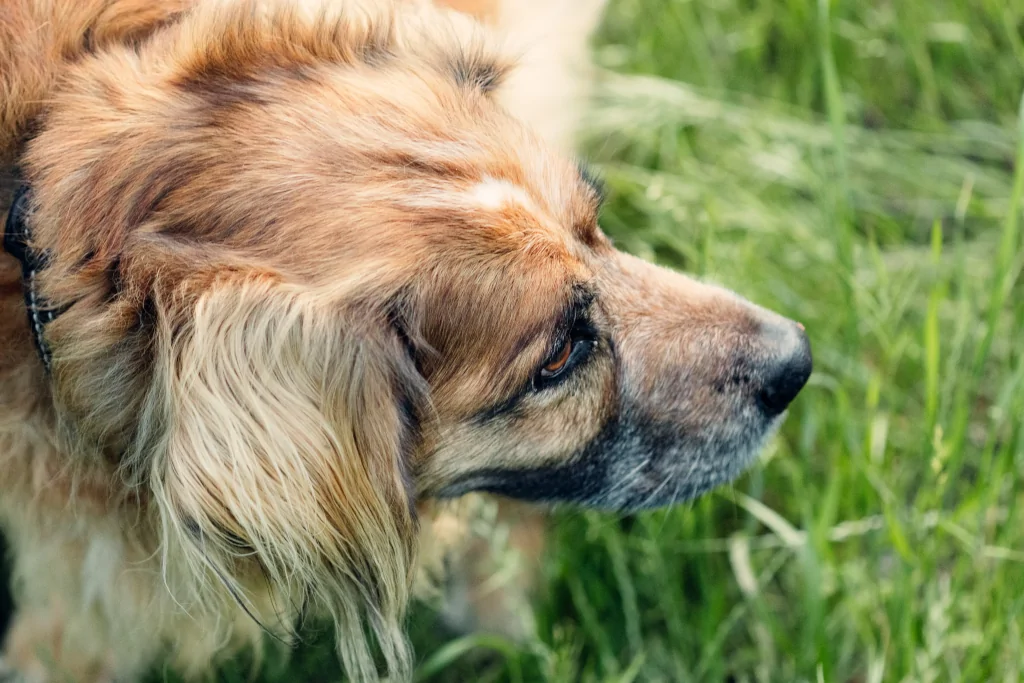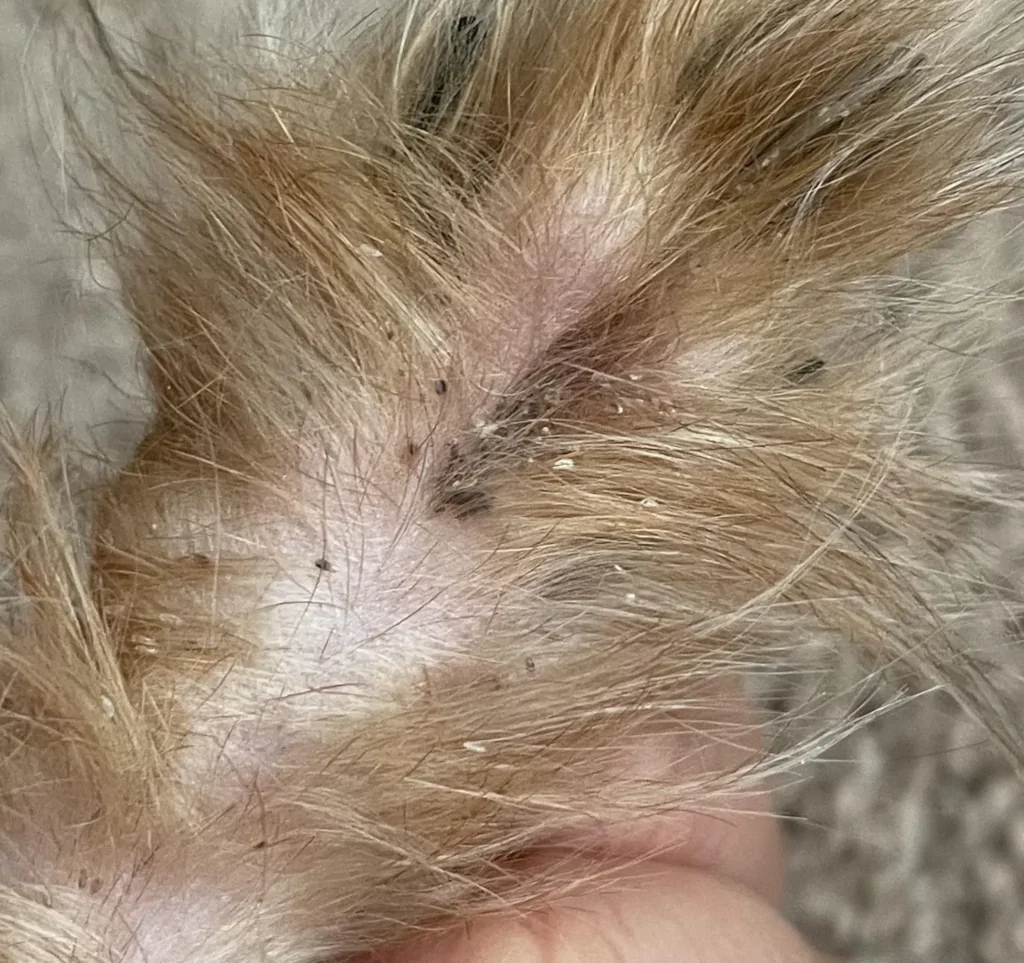Note: We may earn a commission from helpful, relevant links in our content. No cost to you. See our privacy policy.
Does your beloved canine companion seem to be constantly scratching and itching?
If so, there’s a good chance they might be hosting some unwanted guests – fleas.
Fleas aren’t just a nuisance, they can cause discomfort and serious health issues for your dog, turning their carefree days into an itchy nightmare.
But don’t worry, we’ve got the ultimate guide to understanding and tackling this pesky problem, so your furry friend can get back to enjoying a flea-free life.

What Are Fleas and Why Should You Care?
Fleas are tiny, wingless insects that feed on the blood of mammals, with dogs being one of their favorite hosts.
They’re notorious hitchhikers, hopping onto your dog from other animals or infested environments.
Fleas should not be taken lightly. Not only do they cause discomfort and itching, but they can also lead to more serious health issues such as skin infections, anemia, and even transmit diseases like tapeworms.
The thing is, fleas are quite the resilient little buggers, which makes them hard to eliminate. Knowing your enemy is the first step to winning the battle. So, let’s dive into the world of fleas and discover how to keep your dog and home flea-free.
How Can You Tell if Your Dog Has Fleas?
Detecting fleas on your dog might not always be easy, but with a keen eye and some simple strategies, you can identify these unwanted guests. Here are some telltale signs to look for:
- Scratching and itching. If your dog is constantly itching and biting at their skin, fleas might be the culprits. Pay close attention to areas where fleas love to hide, such as the base of the tail, behind the ears, and around the neck.
- Flea dirt. This is essentially flea feces, which looks like tiny black or reddish-brown specks on your dog’s skin or fur. You can confirm it’s flea dirt by placing the specks on a wet paper towel – if they dissolve into red or brownish stains, that’s a sign of flea activity.
- Hair loss. Persistent scratching and biting due to flea bites can lead to hair loss or bald patches on your dog’s coat.
- Flea sightings. Although fleas are tiny, they can still be spotted with the naked eye. Use a flea comb to brush your dog’s fur, focusing on the common hiding spots mentioned earlier. If you find tiny, fast-moving insects, you’ve got fleas.
The Life Cycle of Fleas (Why It Matters)
Understanding the life cycle of fleas is crucial for effective flea control, as it helps you target these pests at their most vulnerable stages. The flea life cycle consists of four stages:
First, adult female fleas lay eggs on your dog’s fur, which can then fall off into the environment. These eggs hatch into larvae within a few days to two weeks, depending on temperature and humidity.
In the second stage, flea larvae are tiny, worm-like creatures that feed on flea dirt and other organic debris. They avoid light and burrow deep into carpets, bedding, or soil. After 5-20 days, they spin a cocoon and enter the pupa stage.
During the pupa stage, the flea larva transforms into an adult flea inside the cocoon. This stage can last anywhere from a few days to several months, depending on environmental conditions. Fleas can emerge from their cocoons when they sense a potential host nearby.
Finally, adult fleas are the biting stage that causes discomfort for your dog. Once they find a host, they start feeding, mating, and laying eggs, completing the life cycle.
Knowing these stages helps you target fleas at every step, not just the adults on your dog. Effective flea control requires treating both your dog and their environment to break the cycle and prevent re-infestation.

Dangers and Risks of Flea Infestations
Flea infestations aren’t just an annoyance; they can pose genuine health risks to your dog and even to you. Here are some key concerns:
- Skin irritation and infections. Flea bites can cause severe itching, leading to excessive scratching and biting, which may result in skin irritation, hot spots, and even infections.
- Flea allergy dermatitis. Some dogs are allergic to flea saliva, causing an intense allergic reaction that leads to severe itching, inflammation, and hair loss.
- Tapeworms. Fleas can carry and transmit tapeworms to your dog when they accidentally ingest fleas while grooming or biting at an itch.
- Anemia. In cases of heavy infestations, especially in young, sick, or elderly dogs, fleas can consume enough blood to cause anemia, which can be life-threatening if not treated promptly.
What Steps Can You Take to Prevent Fleas in Your Home?
Preventing fleas is not only better for your dog’s health but also saves you time and effort in treating an infestation. Here are some effective measures to keep your home flea-free:
Regularly treat your dog
Use veterinarian-approved flea prevention products, such as topical treatments or oral medications, to keep fleas at bay. Follow your vet’s recommendations for the best option and frequency for your dog.
Clean your home
Vacuum carpets, upholstery, and pet bedding frequently to remove flea eggs, larvae, and pupae. Don’t forget to empty the vacuum bag or canister after each use to prevent fleas from escaping back into your home.
Wash pet bedding
Launder your dog’s bedding, toys, and any washable items they come into contact with at least once a week in hot water. This will help eliminate any fleas or their eggs that may be hiding there.
Maintain your yard
Fleas love to hide in shady, moist areas with organic debris. Keep your lawn mowed, trim shrubs, and rake up leaves and other organic material to minimize flea-friendly environments.
Consider preventative treatments for your home
If you live in a flea-prone area, you might want to use a flea control product in your home or yard as a preventive measure. Consult with a professional exterminator or your vet for the best options.
Choosing the Right Flea Treatment for Your Dog
Selecting the right flea treatment for your dog is essential for their comfort and well-being. There are various options available, each with its benefits and drawbacks. Consult with your veterinarian to determine the most suitable treatment for your dog, considering factors like age, size, and health.
Topical treatments
Products like Frontline Plus and Advantage II are applied directly to your dog’s skin, usually between their shoulder blades. They’re easy to use and provide long-lasting protection, typically up to a month.
Keep in mind that they may lose effectiveness if your dog gets wet frequently or is bathed often.
Oral medications
Flea prevention pills like NexGard and Bravecto are given to your dog orally, typically once a month. These medications have the advantage of not being affected by bathing or swimming and can provide quick results.
Remember that some dogs may experience side effects or have difficulty swallowing the pills. To easily give your dog a pill, hide it in their food and feed it to them.
Flea collars
Seresto is a popular flea collar that provides long-lasting protection against fleas, usually for up to eight months. It’s a convenient option for those who don’t want to worry about monthly treatments.
However, some dogs may develop skin reactions or be sensitive to the collar’s ingredients. These are rare and usually mild reactions. If they happen, remove the collar and call the vet for advice.
Natural remedies
While not as potent as chemical treatments, natural remedies like Wondercide Spray use plant-based ingredients to repel and kill fleas. These options are often preferred by pet owners who want to avoid harsh chemicals but may require more frequent application.
To learn more about external parasites that can affect dogs, check our tick protection guide for dogs, and our guide on dog ear mites control.
FAQs
How long can fleas live on a dog?
Adult fleas can live on a dog for about 2 to 3 weeks, during which time they’ll feed, mate, and lay eggs. However, their lifespan can be shorter if they’re removed through grooming, treatment, or if they fall off the dog.
Can fleas infest my home too?
Yes, fleas can infest your home, as their eggs, larvae, and pupae can be found in carpets, upholstery, pet bedding, and other areas.
Are there any natural remedies for flea control?
Natural remedies for flea control include using plant-based sprays like Wondercide Flea & Tick Spray, diatomaceous earth, or essential oils like lavender and lemongrass.
Can my dog get fleas in the winter?
Dogs can still get fleas in the winter, as fleas can survive indoors in heated environments or outdoors in protected areas like animal burrows.
Alex, a passionate animal lover, has experience in training and understanding animal behavior. As a proud pet parent to two dogs and three cats, he founded AnimalReport.net to share insights from animal experts and expand his knowledge of the animal kingdom.









